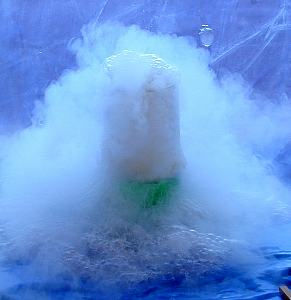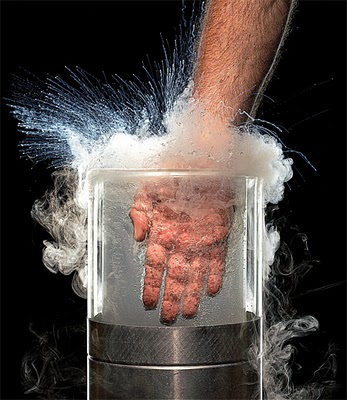8. First Aid (Argon, Helium, Nitrogen, Oxygen).
- If oxygen is being used, be aware of the additional fire hazard.
- Small Skin Exposures

- When the skin is contacted by small droplets of liquefied gasses, the rapid evaporation of
the gas forms a blanket that tends to protect the skin from damage.
- Small droplets can cause more damage if they are in contact with the skin in a confined area.
- In most cases, exposure to small drops of cryogen require no treatment.
- If blistering occurs contact a physician.
- Large Skin Exposures.

- When the skin is contacted by large volumes of liquefied gasses or cold gasses,
severe frostbite can occur.
- Immediately upon exposure, the frozen skin appears waxy and yellow and the burn usually is not painful.
Then, it painfully swells and blisters while the skin defrosts.
- Do not attempt to remove rings or other jewelry.
- Immediately warm frostbitten area with warm water not to exceed 105oF (41oC).
- Be aware that for very large exposures, rewarming may result in shock, and should be carried out
with medical supervision.
- Do not remove clothing that is frozen to skin.
- Do not rub frozen tissue or walk on frozen feet.
- Get emergency medical assistance immediately.
- Eye Exposure
- When the eye is contacted by large volumes of liquefied gasses or cold gasses,
severe frostbite can occur.
- Flush the eyes with warm water not to exceed 105oF (41oC) for at least 15 minutes.
- Do not rub eyes.
- Get emergency medical assistance immediately.
- If the victim is unconscious:
- Be aware that the area may be anoxic (lacking oxygen).
- Do not enter the area unless you are certain that the air is breathable.
- The only ways to be certain that it is safe to enter is to use an oxygen monitor or get information from a witness to the
incident.
- If an oxygen monitor is not available or you have not been trained to use it, wait for emergency services to arrive.
- An oxygen monitor is available in PRIME Lab, and is normally stored in room S-180 when not being used.
- Immediately remove the victim to fresh air if it is safe to do so.
- Access the victim, and if necessary start rescue breathing or CPR.
- Get emergency medical assistance immediately.
|
|
|





